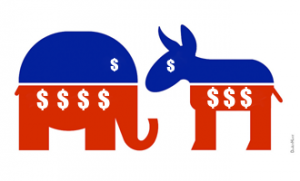Incomes are rising for the wealthiest ten percent of Americans—indeed, skyrocketing for the top one percent and one percent of the one percent—while wages and salaries have stayed largely flat for everyone else over the past several decades. As such disparities become undeniable, political scientists are paying renewed attention to inequality in politics. How have such glaring gaps grown, many ask, in a country we suppose to be a vibrant pluralistic democracy?
Not long ago, most students of American politics believed there were no permanent class divisions and posited that U.S. politics involves multiple, overlapping interest groups, any of which can exercise leverage by organizing and competing. Recently, however, this view has given way to debates about the United States as a “democratic oligarchy” where corporations and fat cats get their way on the things that matter most to them, especially taxes, public budgets, and business regulation.
Many scholars now presume that wealth enjoys undue political influence due to “differential responsiveness”—understood as a perversion of the democratic ideal of government equally accountable to all citizens. The reigning intuition is that privileged interests prevail on matters of special import to them because politicians respond to wealthy donors. Money talks and politicians listen—it’s as simple as that. But before we accept this seemingly obvious model, let’s think more deeply about the mechanisms that could be at work.
Conflict, Public Visibility, and Political Mobilization

Writing in the middle of the twentieth century, the political scientist E. E. Schattschneider argued politics should not be seen as a simple “tug of war” between sides whose relative strength can be calculated in advance based on such ready measures as numbers of people or the dollars each side possesses. Political power is not just a function of underlying nonpolitical resources. Power is, instead, affected by the “scope and bias” of conflict. Schattschneider’s perspective directs our attention to the scale and public visibility of conflicts, and to the forms of political organization that determine alliances and leverage in the public arena.
Schattschneider himself focused on the difference between insider pressure-group politics, which features small-scale, behind-the-scenes maneuvers, and competitive party politics, which is public and features large-scale organizing. When events and organizations put highly visible issues on the agenda and organize masses of people to contend over those issues in elections or other major competitions for power, popular constituencies can compete with, even over-match the wealthy in politics. Conversely, when political decisions are made in back rooms, when issues are obscured and key decisions buried in obscure legislative or regulatory provisions, most citizens, and even many of their leaders, will not understand what is really at stake. Broad-based constituencies remain disengaged, leaving the wealthy and their attentive agents unchallenged.Schattschneider’s emphasis on mobilization paradoxically calls attention to the power of de-mobilization in politics and governance. It follows from his work that we need to pay careful attention to the features of any political system, or of any historical era or moment that mutes political conflict and operates to obscure issues and deflect explicit confrontations. We need to look closely at features of both society and political arrangements that either encourage or discourage—or foster or prevent—mass political organizing.
In the United States over the past few decades, it is not hard to notice demobilizing influences, once we start looking.
- Changes in government rules and management practices have made it much harder for labor unions to organize or maintain memberships. This, in turn, reduces possibilities for unions and the labor movement to exert popular influence in politics.
- Barriers to third party organizing have grown, as the two major parties collude to make it very hard for candidates not aligned with them to get on the ballot.
- Campaign finance practices and the laws and court rulings that regulate campaign finance have made it easier for big money to dominate political messaging and drown out other potential voices, even those that might speak for what millions of Americans care about.
From this perspective, power operates not just through observable instances of elite influence. Power is also manifest in the absence of concerted action and opposition, and in conflicts that do not erupt even when they might be expected.
Are U.S. Political Arrangements Inherently Class Biased?

Various scholars have pursued the Schattschneider line of analysis by asking in what ways and to what extent the U.S. constitutional and party and interest group systems are structured to discourage mobilizations that challenge inequality. Anti-majoritarian features of our system are cited, such as the extra leverage small states have in the Senate and the Electoral College, and the bias of the interest group system toward moneyed or highly ideological interests.
Beyond institutions and organizations, scholars such as Suzanne Mettler point to the hidden nature of many recently expanded benefits. Instead of highly visible programs like Social Security that reach millions of citizens who see clearly what is going on and can hold politicians to account, many recent spending measures take the form of credits or subsidies buried in tax laws or bills negotiated in Congressional committees where inside lobbyists are the only ones who know what is up. Mettler’s work on “the submerged state” suggests that it is not enough to ask “who wins?” It is as or even more important to ask “do affected parties recognize themselves as such?” and “can they mobilize to demand redress?”
In the final analysis, democracy in America is as much distorted by conflicts kept out of the public eye and the possible mobilizations that do not happen, as by wealthy check-writers who grab the ears of politicians. Measuring only the responsiveness of legislators to different kinds of constituents is not enough. And this approach becomes downright misleading when it averts our gaze from dynamics that limit the scope of conflicts and discourage popular mobilization.

 Research to Improve Policy: The Scholars Strategy Network seeks to improve public policy and strengthen democracy by organizing scholars working in America's colleges and universities. SSN's founding director is Theda Skocpol, Victor S. Thomas Professor of Government and Sociology at Harvard University.
Research to Improve Policy: The Scholars Strategy Network seeks to improve public policy and strengthen democracy by organizing scholars working in America's colleges and universities. SSN's founding director is Theda Skocpol, Victor S. Thomas Professor of Government and Sociology at Harvard University.